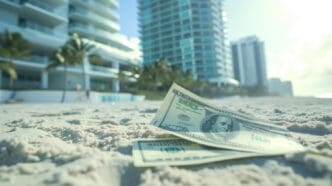KEY POINTS
- For Floridians, a down payment is the initial cash portion of a home’s price, and while 20% is the “gold standard” to avoid Private Mortgage Insurance (PMI), many loan programs require as little as 3-5%.
- A savings strategy for a down payment in Florida should include setting a concrete goal, automating savings into a high-yield savings account, and exploring state-specific assistance programs.
- The Florida Housing Finance Corporation offers various down payment and closing cost assistance programs, such as the Hometown Heroes program for community workers, veterans, and military members, which can provide a deferred second mortgage of up to $35,000.
Miami, FL – The dream of homeownership is deeply woven into the fabric of life in the Sunshine State. It’s the vision of a backyard lanai for family barbecues, a first home in a burgeoning community, or a coastal condo with a view of the water. But before the keys are in hand, there is a crucial first mountain to climb: saving for a down payment.
For Floridians navigating one of the most dynamic real estate markets in the country, this initial step can feel like the most daunting. However, with a clear strategy and disciplined approach, accumulating the funds for a down payment is an achievable goal. This guide will break down everything you need to know to turn your homeownership dream into a reality.
What Exactly is a Down Payment?
A down payment is the portion of a home’s purchase price that you pay upfront in cash. It is not part of your mortgage loan. Instead, it represents your initial stake—or equity—in the property. Lenders require a down payment as a sign of your financial commitment and to reduce their own risk. A larger down payment means you need to borrow less money, which can result in a lower monthly mortgage payment and less interest paid over the life of the loan.
How Much Do You Really Need to Save?
The most common myth about down payments is that you absolutely need 20% of the home’s purchase price. While putting down 20% has significant advantages, many loan programs allow for much less.
- The 20% Gold Standard: Putting down 20% allows you to avoid Private Mortgage Insurance (PMI). PMI is an extra monthly fee added to your mortgage payment that protects the lender in case you default on your loan. It offers no benefit to you and can add hundreds of dollars to your monthly costs.
- Low Down Payment Options (3% to 5%): Many conventional loans are available with as little as 3% down. Government-backed loans like FHA loans require as little as 3.5% down, making them a popular choice for first-time homebuyers.
- No Down Payment Options (0%): For eligible military service members, veterans, and surviving spouses, VA loans are an incredible benefit that requires no down payment. Similarly, USDA loans for homes in eligible rural areas also offer a 0% down payment option.
Don’t Forget Closing Costs: Your down payment is not the only cash you’ll need. Closing costs, which cover expenses like appraisal fees, title insurance, and loan origination fees, typically range from 2% to 5% of the home’s purchase price. You must budget for these expenses separately.
A Savings Strategy for the Sunshine State
Building a substantial savings fund requires a dedicated plan. Here’s how to create one tailored for success in Florida.
- Set a Concrete Goal: First, determine a realistic price range for the home you want to buy. With Florida’s diverse market, this will vary greatly from the Panhandle to Palm Beach. Once you have a target purchase price, calculate your down payment goal (e.g., 5% of $350,000 is $17,500) and add an estimated 3% for closing costs ($10,500). Your total savings goal would be $28,000.
- Automate Everything: Open a dedicated High-Yield Savings Account (HYSA) separate from your regular checking account. Then, set up an automatic transfer from your checking to your HYSA for every payday. This “pay yourself first” method ensures you are consistently saving before you have a chance to spend the money.
- Create a “Down Payment” Budget: Scrutinize your monthly expenses. Can you reduce dining out, cut back on subscription services, or find a more affordable car insurance plan? Every dollar you trim from your budget is another dollar you can redirect to your down payment fund.
- Look for Florida-Specific Help: Don’t go it alone. The Florida Housing Finance Corporation (Florida Housing) offers several down payment and closing cost assistance programs for first-time homebuyers. These programs can provide thousands of dollars in the form of low-interest loans or grants, significantly reducing the amount you need to save.
Where to Keep Your Savings: Safety First
When saving for a goal that is only a few years away, the number one priority is protecting your principal. This is not the time to chase high returns in the stock market.
- High-Yield Savings Accounts (HYSAs): This is the ideal place for your down payment fund. HYSAs are FDIC-insured up to $250,000, meaning your money is completely safe. They are also liquid, so you can access your funds when you need them. Most importantly, they offer significantly higher interest rates than traditional savings accounts, allowing your money to grow while you save.
- Certificates of Deposit (CDs): If you have a portion of your savings that you won’t need to touch for a fixed period (e.g., one year), a CD can offer a slightly higher, guaranteed rate of return.
Your Path to Homeownership
Saving for a down payment is a marathon, not a sprint. It requires patience, discipline, and a clear plan. By breaking down your goal into manageable steps, automating your savings, and taking advantage of the resources available to you as a Floridian, you can systematically build the funds you need. Each automated transfer and every conscious spending decision is a step closer to unlocking the door to your new home in the Sunshine State.







